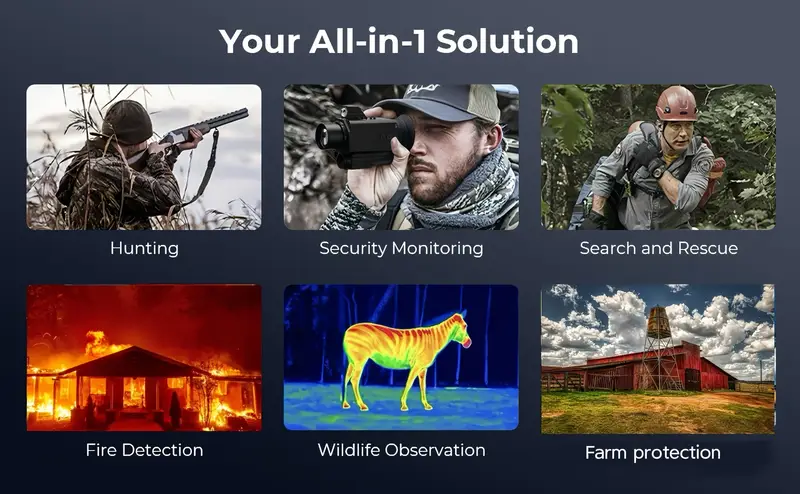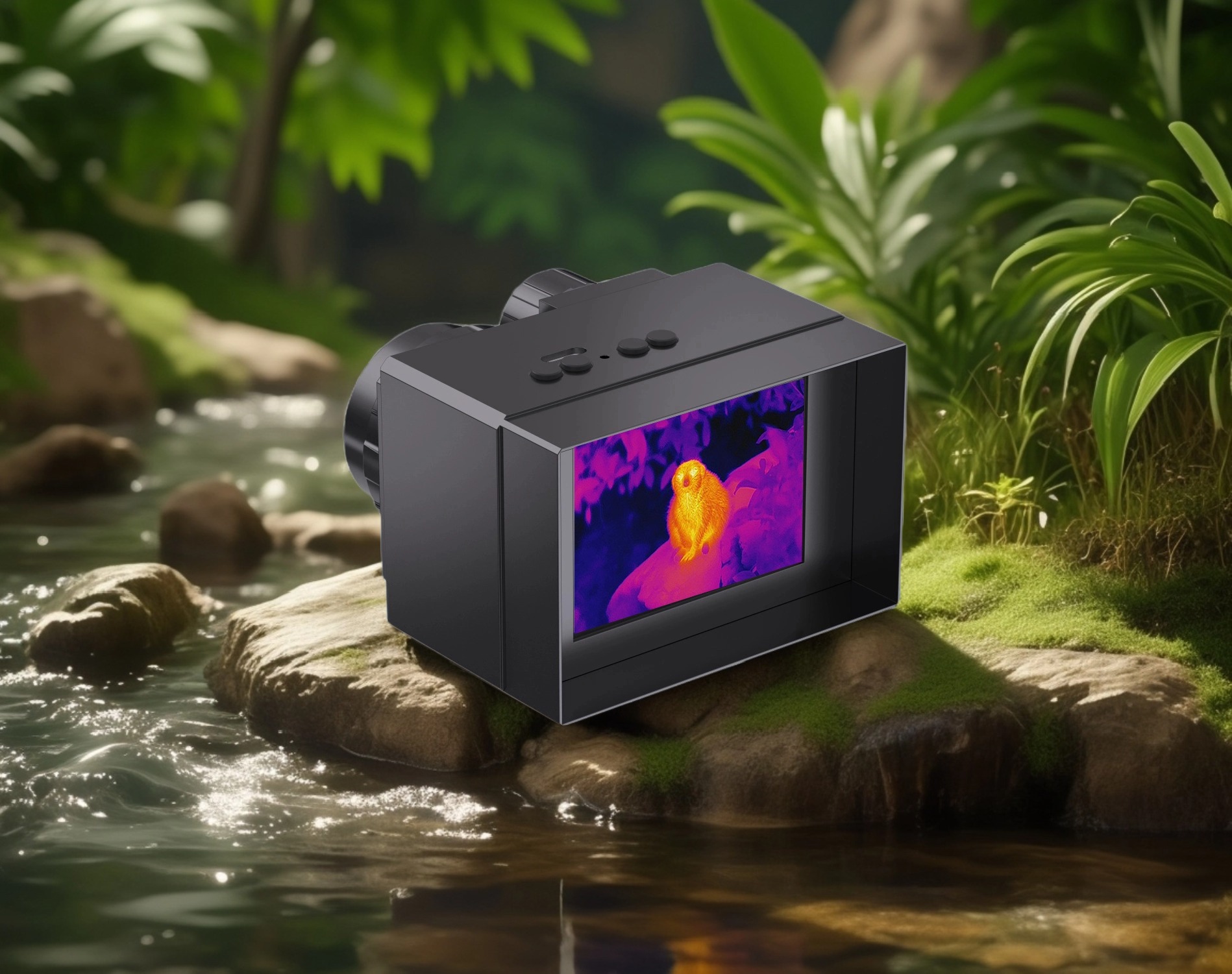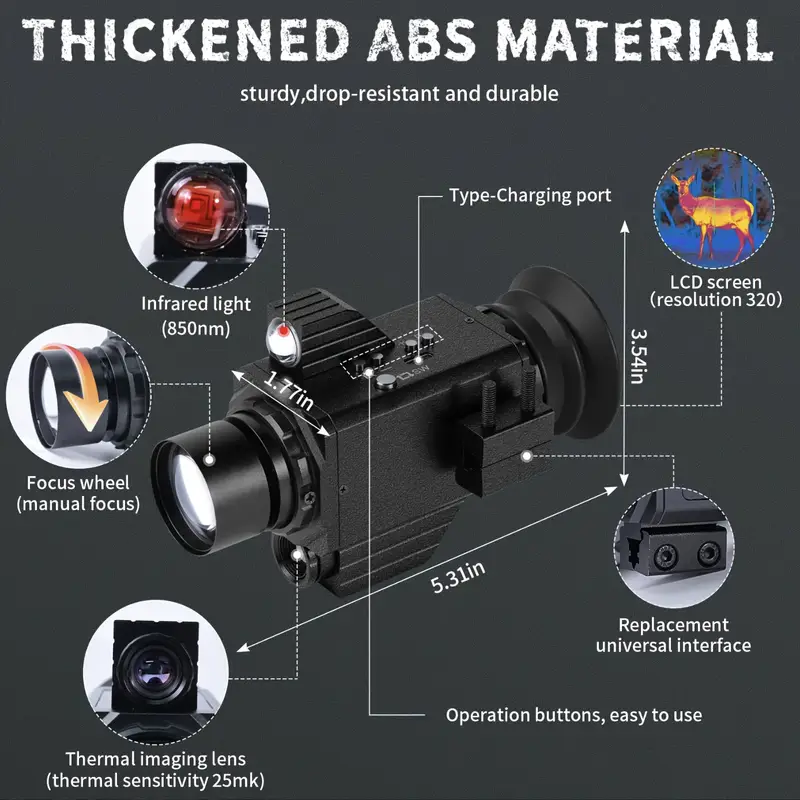Thermal Scope
Thermal scopes are revolutionising the way we see the world. They use infrared technology1 to detect heat signatures. This makes them invaluable in low-light or no-light conditions.
Hunters, tactical professionals, and outdoor enthusiasts find them indispensable. They offer a distinct advantage when tracking nocturnal animals, such as hogs and coyotes.
But what makes a good thermal scope? Key features include resolution, refresh rate, and detection range2. Battery life is also crucial for extended use.
Thermal scopes can be pricey, ranging from a few hundred to several thousand dollars. However, budget options are available for those with limited funds.
Choosing the best thermal scope involves balancing performance, features, and price. It’s important to consider your specific needs and preferences.
As technology advances, new thermal scopes promise even better performance. Whether for hunting, tactical use, or general observation, thermal scopes are a game-changer.

What Is a Thermal Scope?
Thermal scopes are advanced devices that detect infrared radiation. Unlike regular scopes, they visualise heat emitted by objects and living beings. This feature allows for enhanced visibility in darkness and through light obstructions like fog.
A thermal scope is not limited to nighttime use. It can also be effective during the day, offering unique tracking capabilities. These scopes excel where regular scopes fall short.
Thermal scopes are versatile, applicable in numerous scenarios. They’re commonly used in hunting and tactical operations. Their ability to detect warm bodies makes them effective and reliable.
In essence, thermal scopes convert heat into an image visible to the human eye. This helps in identifying targets quickly and efficiently. The technology provides a competitive edge in various situations.
Key components of a thermal scope include:
- An infrared detector
- A lens to focus infrared light
- An image processor
Understanding these elements helps users choose the right scope for their needs. As technology evolves, thermal scopes continue to improve in resolution and clarity, making them even more valuable tools.
How Does a Thermal Scope Work?
A thermal scope operates by detecting infrared energy. This energy is naturally emitted by all objects as heat. The scope captures this heat and converts it into a visual image.
An essential component of the thermal scope is the infrared sensor. This sensor, often called a microbolometer, records heat levels. It then sends this information to the scope’s processor.
The processor analyses these heat patterns. It converts them into a detailed digital image that users can see. This image allows users to observe even in absolute darkness.
Thermal scopes do not require light to function. This sets them apart from other types of scopes, like night vision. They are not influenced by light conditions.
Important features for understanding thermal scope functionality include:
- Infrared sensors: Detect heat signatures
- Image processors: Convert data into viewable images
- Displays: Present images in real time

Thermal Scope vs. Night Vision: Key Differences
Thermal scopes and night vision devices serve similar purposes, but they are fundamentally different. Each uses distinct technology to enhance visibility in low-light situations.
Night vision scopes amplify existing light. They use ambient light from the stars or moon to create an image. This means they are less effective in complete darkness.
Thermal scopes, in contrast, detect heat emissions. They can operate in total darkness without any light source. This ability makes them particularly useful in varying environments.
Key differences between the two include:
- Light Dependence: Night vision needs light; thermal does not.
- Detection Method: Night vision amplifies light; thermal detects heat.
- Applications: Thermal scopes can be used in daylight; night vision cannot.
Choosing between the two depends on specific needs and conditions. However, thermal scopes offer broader versatility by working both day and night.
Main Uses for Thermal Scopes: Hunting, Tactical, and More
Thermal scopes are versatile tools utilised in various fields. They excel in detecting heat, making them indispensable for several activities.
In hunting3, thermal scopes give significant advantages. They enable hunters to spot game in low light or dense brush. This is particularly useful for nocturnal animals, such as hogs and coyotes.
Tactical applications also benefit greatly from thermal scopes. Law enforcement and military units use them for surveillance. They can detect hidden objects or people due to their ability to see through smoke and fog.
Here’s how thermal scopes are commonly used:
- Hunting: Effective in spotting nocturnal or camouflaged animals.
- Tactical Ops: Used in law enforcement for clear visibility.
- Wildlife Observation: Useful for studying animal behaviour in any light.

Beyond these, thermal scopes assist in search and rescue operations. Their unique abilities make them ideal for locating individuals in difficult conditions. This versatility ensures they are essential in diverse situations, offering enhanced visibility and detection capabilities.
Key Features to Look for in a Thermal Scope
Choosing a thermal scope involves understanding its critical features. Each component impacts performance, so consider your specific needs.
Resolution4 is crucial for image clarity. A higher resolution offers better detail, making it easier to identify targets. This is essential for hunters and tactical users alike.
Detection range5 determines how far you can spot heat sources. A good range is important for long-distance observations, especially in open fields.
Battery life6 can’t be overlooked. Longer battery life ensures the scope lasts through extended operations. This is key for those on lengthy excursions or patrols.
When evaluating thermal scopes, consider:
- Resolution: Higher pixels provide clearer images.
- Detection Range: Look for longer ranges for open terrains.
- Battery Life: Essential for uninterrupted use.
- Refresh Rate: Impacts the fluidity of moving images.
- Durability: Should withstand harsh conditions and recoil.

Additionally, a higher refresh rate helps track moving targets smoothly. This feature is especially useful during fast-paced activities. Lastly, durability ensures your scope withstands tough environments, making it a trustworthy companion.
Top Brands: Who Makes the Best Thermal Scope?
In a market filled with options, certain brands stand out for their quality and innovation. These companies consistently deliver reliable and high-performing thermal scopes.
FLIR7 is a leader in thermal imaging technology. They are renowned for their durable and advanced thermal optics. Many users trust FLIR for both professional and recreational activities.
ATN is another top contender. Their scopes are known for excellent features and user-friendly interfaces. ATN is especially popular among hunters and tactical professionals.
Pulsar8 offers a range of scopes recognised for innovation and excellent performance. They continually push the limits of thermal technology. Pulsar’s products are favoured by those needing dependable and clear imaging.
Best Thermal Scopes for Different Needs
Thermal scopes cater to a variety of needs. They offer solutions for different hunting, tactical, and budget requirements. Understanding the ideal scope for your situation enhances your effectiveness in the field.
For those using an AR-15, the right thermal scope should be lightweight and compact. This ensures easy manoeuvrability and quick target acquisition. Choosing a scope that mounts easily and offers solid stability is crucial.
Hunters focusing on hogs and coyotes require scopes with long detection ranges. This allows spotting animals at distances with precision. Features like wide fields of view and high resolution also enhance the hunting experience.
Budget scopes offer an entry point without compromising too much on essential features. These scopes provide core functionality for those new to thermal technology or on a tight budget.
Key factors to consider for different needs include:
- Weight and Compactness: Essential for AR-15 users.
- Detection Range: Crucial for hog and coyote hunting.
- Cost-Effectiveness: Important for budget-conscious buyers.
Explore models best suited for your specific requirements. Understanding these needs ensures a more satisfying and productive experience.
Best Thermal Scope for AR-15
AR-15 owners need scopes that complement the rifle’s design. These scopes should be lightweight yet durable, ensuring balance and ease of use.
For the best experience, consider scopes with quick attachment mechanisms. Features like easy reticle adjustments enhance shooting precision during diverse scenarios.
Popular choices for AR-15 enthusiasts often include:
- Quick Detach Mounts: For easy switching.
- Variable Magnification: To adapt to various ranges.
Best Thermal Scope for Hog and Coyote Hunting
Hunting hogs and coyotes requires thermal scopes with specific attributes. These animals are typically active at night, demanding reliable night-time capabilities.
Scopes with long-range detection and high-definition imagery prove advantageous. Wider fields of view help scan large areas swiftly, crucial when tracking mobile targets.
Effective scopes for this purpose often include:
- High Resolution: For clear, detailed visuals.
- Wide Field of View: Assists in covering expansive areas.
Best Budget and Affordable Thermal Scopes
Budget-conscious buyers often seek affordable thermal scopes offering essential features without breaking the bank. Entry-level options can still provide good resolution and adequate detection range.
Features like robust construction and user-friendly design make these scopes appealing. They allow enthusiasts to explore thermal imaging without high costs.

Affordable thermal options typically include:
- Basic Detection Range: Sufficient for most uses.
- User-Friendly Interface: Simplifies operation.
Finding a cost-effective scope ensures accessibility to thermal technology for a wider audience.
How Much Does a Thermal Scope Cost?
Thermal scopes vary widely in price. Entry-level models start at a few hundred dollars, offering basic features. These budget options suit those new to thermal technology or with simple needs.
Mid-range scopes can cost between $1,000 to $3,000. They often provide better resolution, detection range, and additional functionalities. These models are ideal for more seasoned users seeking improved performance.
High-end thermal scopes exceed $3,000. They deliver top-notch technology with advanced features such as integrated rangefinders and video recording capabilities. Such scopes target professionals needing the best in precision and reliability.
When budgeting for a thermal scope, consider:
Initial Investment: Influences the range of features.
Intended Usage: Determines the necessary specifications.
Durability and Longevity: Justifies the cost over time.
New Thermal Scopes for 2025: What to Expect
The future of thermal scopes is exciting, with constant innovation, driven by demand for improved capabilities. By 2025, we can anticipate significant advancements.
Enhanced resolution9 and extended battery life are on the horizon. These improvements will provide users with clearer images and longer operation times in the field. Moreover, compact designs will make thermal scopes more portable without sacrificing performance.
Expect new features like smart connectivity10 and artificial intelligence integration. These could include:
- Real-Time Data Transfer
- AI-Powered Target Recognition11
- Improved User Interfaces
These innovations will make thermal scopes even more versatile, catering to a broader range of applications and preferences. As technology advances, users will benefit from enhanced precision and efficiency in various environments.
Frequently Asked Questions About Thermal Scopes
Choosing a thermal scope raises many questions. Here are some common queries and concise answers to guide you.
- What is a thermal scope?
A device that uses infrared technology to detect heat signatures. - How does a thermal scope differ from night vision?
Thermal scopes detect heat, while night vision amplifies available light. - Can thermal scopes be used in daylight?
Yes, they operate effectively in both day and night. - What affects the price of a thermal scope?
Features like resolution, range, and additional capabilities, such as rangefinders. - Are there budget-friendly options12?
- Do thermal scopes require maintenance?
Basic care ensures longevity, such as keeping lenses clean and replacing batteries as needed.
Conclusion: Finding the Right Thermal Scope for Your Needs
Selecting a thermal scope involves understanding your specific requirements and budget. Consider the type of environment and intended use, like hunting or tactical operations.
Research the features that are most crucial for you, such as resolution, detection range, and battery life. These elements will significantly affect performance and user satisfaction.
A well-chosen thermal scope enhances your capabilities, whether for hunting or protection. Evaluate your needs carefully and choose a scope that delivers the best value and meets your expectations.
Yes, but they may lack some advanced features of high-end models.
-
Understanding infrared technology is key to appreciating how thermal scopes function, making this resource essential for enthusiasts and professionals alike. ↩
-
Learn about the factors influencing detection range to make an informed decision when selecting a thermal scope that meets your needs. ↩
-
Discover insights on how thermal scopes can significantly increase your chances of a successful hunt, especially in low-light conditions. ↩
-
Understanding resolution helps you choose a thermal scope that provides clear images, crucial for accurate target identification. ↩
-
Exploring detection range will guide you in selecting a scope that meets your long-distance observation needs effectively. ↩
-
Learning about battery life ensures you select a thermal scope that can sustain prolonged use during your activities. ↩
-
Learn why FLIR is trusted by professionals and enthusiasts alike for their durable and advanced thermal optics. ↩
-
Find out how Pulsar is pushing the boundaries of thermal technology with their innovative products. ↩
-
Explore how enhanced resolution can significantly improve your thermal imaging experience and decision-making in the field. ↩
-
Learn about smart connectivity features in thermal scopes that can revolutionize your user experience and data management. ↩
-
Discover the cutting-edge technology behind AI-powered target recognition and how it enhances accuracy and efficiency in thermal imaging. ↩
-
Find affordable thermal scope options that fit your budget without compromising on quality. ↩
